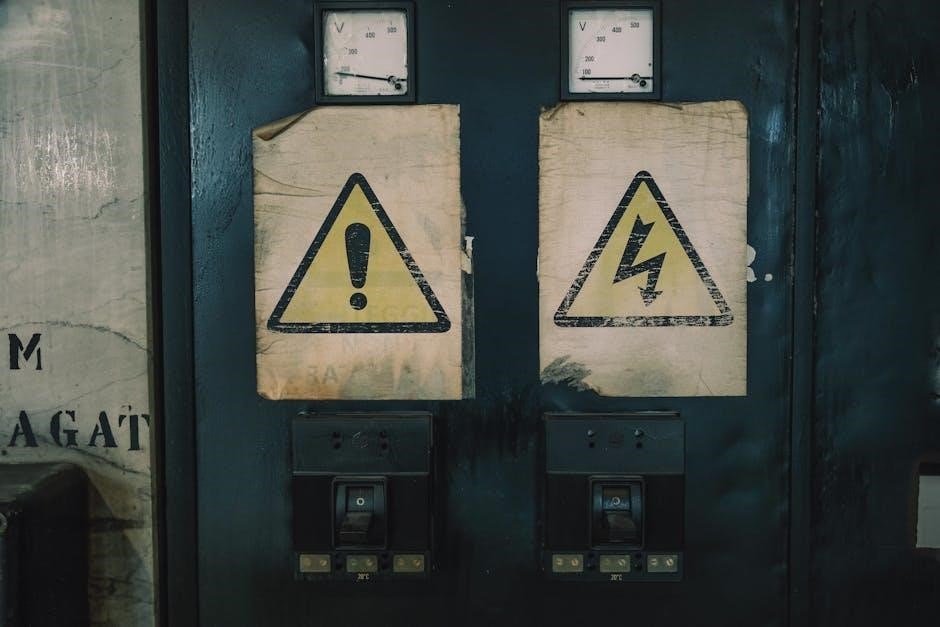Manual transmissions can develop issues over time, often showing signs like difficulty shifting gears, grinding noises, or fluid leaks, which can lead to costly repairs if ignored.
1.1 Understanding the Basics of Manual Transmissions
A manual transmission, also known as a stick shift, is a type of gearbox that requires the driver to manually change gears using a clutch pedal and gearshift. The system relies on the clutch to disconnect engine power during gear changes, allowing smooth transitions between gears. The transmission consists of gears, bearings, and synchronizers, which work together to provide control over speed and torque. Understanding these components is essential for identifying issues early, as wear and tear can lead to common problems like difficulty shifting or unusual noises. Regular maintenance, such as fluid checks, is crucial to ensure optimal performance and longevity.
1.2 Importance of Identifying Problems Early
Identifying manual transmission issues early is crucial to prevent minor problems from escalating into major repairs. Early detection of symptoms like grinding noises, difficulty shifting, or fluid leaks can save significant costs. Neglecting these signs often leads to more severe damage, such as gear wear or synchronizer failure, which can render the transmission inoperable. Regular inspections and prompt action ensure smoother performance, maintain fuel efficiency, and extend the lifespan of the transmission. Addressing problems early also enhances safety, as faulty transmissions can lead to unexpected loss of control while driving. Proactive maintenance is key to avoiding costly and time-consuming repairs down the road.

Common Symptoms of a Failing Manual Transmission
A failing manual transmission often exhibits symptoms such as difficulty shifting gears, grinding or clunking noises, slipping between gears, and fluid leaks, signaling potential internal damage.
2.1 Difficulty Shifting Gears
Difficulty shifting gears is a common symptom of a failing manual transmission. This can manifest as a stiff or unresponsive gearshift, making it hard to transition between gears smoothly. Causes may include worn-out synchronizers, low transmission fluid levels, or clutch problems. If the issue persists, it can lead to further damage, such as stripped gears or complete transmission failure. Early identification is crucial to prevent costly repairs. Drivers may notice hesitation or resistance when shifting, especially when accelerating or decelerating. Consulting a mechanic promptly is recommended to address the root cause and ensure proper transmission function.
2.2 Grinding or Clunking Noises
Grinding or clunking noises when shifting gears are clear indicators of a manual transmission problem. These sounds often result from worn-out gears, damaged synchronizers, or insufficient transmission fluid. If left unaddressed, they can lead to catastrophic damage, such as gear failure or complete transmission breakdown; The noises may be more pronounced during acceleration or when shifting into specific gears. Ignoring these signs can escalate the issue, making repairs more complex and expensive. It’s essential to investigate the cause promptly to prevent further deterioration and ensure the transmission operates smoothly.
2.3 Slipping or Hesitation Between Gears
Slipping or hesitation between gears is a concerning symptom of a failing manual transmission. This occurs when the gears fail to engage properly, causing the car to momentarily lose power or struggle to accelerate. Such issues are often linked to worn-out clutch components, low transmission fluid levels, or internal damage to the gear teeth or bearings. If the transmission hesitates or slips frequently, it can lead to unsafe driving conditions and further mechanical damage. Addressing this problem early is crucial to avoid costly repairs and ensure smooth gear transitions while driving.
2.4 Leaking Fluid
Leaking transmission fluid is a clear indicator of a manual transmission issue. Over time, seals or gaskets within the system can wear out, leading to fluid escaping. This leakage can result in low fluid levels, which impair the transmission’s ability to lubricate and cool internal components. If left unaddressed, the lack of proper lubrication can cause gears and bearings to overheat and wear down prematurely. Regularly checking for signs of fluid leaks around the transmission pan, drain plug, or gear shaft can help identify this problem early, preventing further damage and ensuring the system operates smoothly.

Performance-Related Signs of a Bad Manual Transmission
A failing manual transmission often leads to reduced acceleration, unusual vibrations, and sudden jerking, significantly impacting the vehicle’s overall performance and driving experience.
3.1 Reduced Acceleration or Power
A common sign of a failing manual transmission is reduced acceleration or power. This occurs when the transmission struggles to transfer engine power efficiently to the wheels. Drivers may notice the vehicle hesitating or lagging during acceleration, especially when climbing hills or merging onto highways. Over time, worn or damaged components inside the transmission can disrupt the flow of power, leading to a noticeable decrease in performance. If left unchecked, this issue can progress, making the vehicle feel sluggish and unresponsive, which can be both frustrating and unsafe on the road.
3.2 Unusual Vibrations While Driving
Unusual vibrations while driving can indicate a problem with the manual transmission. These vibrations may feel like shaking or trembling through the clutch pedal, gearshift, or even the entire vehicle. Such vibrations often result from worn-out bearings, misaligned gears, or damaged shafts within the transmission. If left unaddressed, these vibrations can lead to more severe damage, affecting the overall driving experience and safety. Persistent or worsening vibrations are a clear sign that professional inspection and repair are necessary to prevent further complications and ensure smooth operation of the vehicle.
3.3 Sudden Jerking or Lunging
Sudden jerking or lunging while driving can be a concerning symptom of a faulty manual transmission. This typically occurs when the transmission fails to engage gears smoothly, causing the vehicle to lurch forward or backward unexpectedly. Such behavior may result from worn-out synchronizers, damaged gear teeth, or issues with the clutch mechanism. These abrupt movements can be unsettling for drivers and passengers alike, potentially leading to loss of control. Addressing this issue promptly is crucial to avoid further damage to the transmission and ensure safe operation of the vehicle.

Causes of Manual Transmission Failure
Manual transmissions fail due to high mileage, clutch wear, and insufficient maintenance, leading to worn gears, synchronizers, and bearings, which compromise smooth operation and reliability.
4.1 High Mileage and Wear
High mileage and wear are primary contributors to manual transmission failure. Over time, gears, bearings, and synchronizers degrade, leading to difficulty shifting and noisy operation. As components wear, lubrication becomes less effective, accelerating damage. Symptoms like grinding noises, slipping gears, and leaks often emerge. Regular maintenance can delay wear, but eventually, high-mileage transmissions may require rebuilding or replacement to restore functionality and prevent catastrophic failure. Addressing wear early is crucial to avoid costly repairs and ensure smooth, reliable performance.
4.2 Clutch Wear or Failure
Clutch wear or failure significantly impacts manual transmission performance. As the clutch wears, it may slip or fail to engage properly, causing hesitation or jerking when shifting gears. Signs include a spongy pedal feel, unusual noises during acceleration, and difficulty changing gears. If the clutch fully fails, the engine may disconnect from the transmission, making it impossible to accelerate. Replacing the clutch early prevents further damage to transmission components. Proper driving habits and regular inspections can extend clutch life, ensuring smooth and efficient gear engagement.
4.3 Insufficient Maintenance
Insufficient maintenance is a leading cause of manual transmission failure. Neglecting regular fluid changes and filter replacements can lead to contamination and premature wear of internal components. Without proper lubrication, gears and bearings suffer increased friction, accelerating damage. Additionally, ignoring maintenance schedules can result in costly repairs down the line. Regular checks and timely replacements of worn parts are crucial to extending the transmission’s lifespan and ensuring smooth operation. Overlooking these steps often leads to severe issues, including complete transmission failure, which can be both expensive and time-consuming to resolve.

When to Visit a Professional Mechanic
If you notice persistent noises, vibrations, or difficulty shifting gears, it’s crucial to consult a professional mechanic to diagnose and address issues before they escalate.
5.1 Persistent Noises or Vibrations
Persistent noises or vibrations while driving often indicate underlying issues with the manual transmission. Grinding or clunking sounds during gear shifts may signal worn synchronizers or damaged gear teeth. Vibrations could point to imbalanced or loose components within the transmission system. If these symptoms are consistent and worsening, it’s essential to seek professional inspection. Ignoring these signs can lead to more severe damage, resulting in costly repairs or even transmission failure. A mechanic can diagnose the root cause and recommend appropriate fixes to ensure safe and smooth operation of the vehicle.
5.2 Inability to Shift Gears Properly
The inability to shift gears smoothly or engage them fully is a critical sign of manual transmission trouble. If gears hesitate, stick, or refuse to engage, it may indicate worn-out synchronizers, damaged gear teeth, or a failing clutch. This issue can occur due to high mileage, improper clutch operation, or insufficient lubrication. If left unchecked, it can lead to complete transmission failure. Consulting a professional mechanic is crucial in such cases, as early diagnosis can prevent further damage and costly repairs. Persistent gear-shifting problems should never be ignored, as they compromise both performance and safety.

Diagnostic Steps for Manual Transmission Problems
Diagnosing manual transmission issues involves visual inspections, test driving, and checking for leaks or unusual noises. These steps help identify problems early, preventing further damage.
6.1 Visual Inspection of the Transmission
A visual inspection is the first step in diagnosing manual transmission problems. Mechanics check for signs of wear, such as rust, dents, or cracks in the casing. They also look for fluid leaks around seals and gaskets, which can indicate internal damage. Additionally, inspecting the clutch and gear components for excessive wear or corrosion helps identify potential issues early. This step is crucial for determining if repairs are needed or if the transmission requires replacement. Regular inspections can prevent minor issues from escalating into major problems.
6.2 Test Driving to Identify Issues
Test driving is a critical diagnostic step for identifying manual transmission problems. During the drive, mechanics observe how the transmission performs under various conditions. They check for smooth gear transitions, noting any hesitation or resistance. Grinding or clunking noises during shifts are recorded, as are any unusual vibrations. Slipping or delayed engagement of gears is also evaluated. The driver pays attention to how the clutch engages and disengages, as irregular behavior can indicate issues like worn clutch facings or pressure plate problems. This hands-on approach helps pinpoint specific faults, guiding further inspection or repair needs.

Replacement and Repair Considerations
Replacement or repair depends on the severity of damage. Weighing repair costs against replacement is crucial, especially for high-mileage vehicles or those with significant wear.
7.1 Knowing When Replacement is Necessary
Replacement is necessary when repairs are no longer cost-effective. Signs include severe gear damage, extensive wear on internal components, or complete loss of functionality. If the transmission cannot engage gears or operates erratically, replacing it ensures safety and reliability. High-mileage vehicles with significant wear may also require replacement. Consulting a professional mechanic helps determine if repair or replacement is the best option. Early detection of these signs prevents further damage and ensures optimal performance. Always prioritize safety and functionality when deciding between repair and replacement.
7.2 Costs and Time Involved in Repairs

Manual transmission repairs can vary significantly in cost, depending on the extent of damage. Replacing internal components like gears or bearings may cost between $500 and $2,000, while a complete overhaul can range from $1,000 to $3,000. Labor costs are typically higher for manual transmissions due to the complexity of disassembly and reassembly. The time required for repairs can range from a few days to several weeks, especially if parts need to be ordered. Early detection of issues can help minimize both cost and downtime, making it crucial to address problems promptly to avoid more extensive repairs.